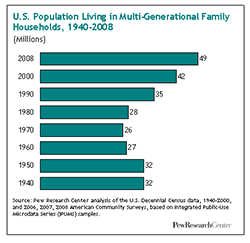Home Building Articles
Make Room For Grandparents and Boomerangs
March 31, 2010
The number of Americans living in multigenerational households grew by 2.6 million
from 2007 to 2008 and continues to rise, according to a Pew Research Study.
Related Articles
Save/Share

Does that nifty new floor plan of yours have enough bathrooms? It's a question that
may be worth revisiting in light of a recent study by the Pew Research Center that shows that
the extended family is making a comeback.
Analyzing Census data, Pew researchers found that in 2008, 49 million Americans
(about 16%) lived in a household that contained at least two adult generations,
up from 28 million in 1980.
This 33% increase over the past three decades represents a significant reverse trend,
considering multigenerational households declined by more than half between 1940
and 1980, from 25% to 12%.
Now, the age of the relatively smaller nuclear family household could be waning
as a result of cultural expectations and sobering economic constraints. Rising immigrant
populations are certainly one contributor. Asians currently account for 25% of all
multigenerational households, researchers found, followed by blacks (23%) and Hispanics
(22%).
Whites represent only 13% of such households, and their share of the total population
continues to shrink. The U.S. Census Bureau recently reported 2010 as the tipping
point year when more babies born in the U.S. are expected to be minority than white.
The fact that today's young adults tend to marry later in life, combined with the
recession, may also be driving up the number of multigenerational homes. The average
American man now weds for the first time at age 28; for women, the median age is
26. Put in context, this means that both genders are now getting hitched about five
years later than they were in 1970.
As a result, there are more unmarried 20-somethings floating around in the general
population, and many of them are finding the prospect of living at home with Mom
and Dad pretty sensible--particularly at a time when economic conditions are making
it harder to find a job, much less qualify for a mortgage. In 1980, just 11% of
adults ages 25 to 34 lived in multigenerational households. Now, more than 20% do.
High unemployment and rising foreclosures are no doubt compelling many Americans
to rethink the benefits extended family households. A Pew analysis of Bureau of
Labor Statistics data found that as of 2009, 37% of 18- to 20-year-olds were either
unemployed or out of the workforce--the highest share in this age group in four
decades. This finding dovetails with a separate 2009 Pew survey which revealed similar
results: among 22- to 29-year-olds, one in eight said that the recession had prompted
them to boomerang back home after living on their own.
The aging of America is beginning to shape the housing landscape as well. The share
of adults aged 65 and older living with their kids or grandkids is now about 27%,
up from 17% in 1980. Demographers cite "kin availability" as a compelling proposition
when life circumstances change due to widowhood, declining health or financial constraints.
Many older adults with health or mobility limitations are finding that having an
adult child serve as an informal caregiver is more financially viable than an assisted
living community.
Gender breakdowns tend to vary by age, however, with men more likely to live in
multigenerational households when they are younger. The study found that 22% of
men between the ages of 25 and 34 live in such households, compared to 18% of women,
but then the ratio flips. Some 23% of women between the ages of 55 and 64 live in
a multigenerational household, compared to only 18% of men. This discrepancy is
similar among Americans who are 75 and older – a reflection, at least in part, that
women tend to outlive men.
Of the 49 million Americans who currently live in a multigenerational residence,
47% live in a household made up of two adult generations in the same family (with
the youngest adult at least 25 years old). Another 47% live in a household with
three or more generations of family members under one roof. Some 6% live in a "skipped
generation" household made up of a grandparent and grandchild, but no parent.
The primary breadwinner and head of household tends to be the older adult in about
75% of cases, the report found. However, that hierarchy begins to shift when the
parent is 65 or older.
What about all those market predictions forecasting the rise of the single home
buyer? Interestingly, the study found it to be just as viable a trend as the multigenerational
household.
Researchers noted a steady rise over the past century in the number of single-person
households, which in 1900 accounted for just 1.1% of U.S. households. Today, that
situation represents 10.3% of all households.
In terms of an age breakdown for this type of household, just 4.6% of young adults
(ages 18 to 24) live alone, down from 5.7% in 1980. Singles are more prevalent in
the 65+ population, although their numbers have declined slightly with the recession.
The number of 65+ adults living alone peaked at 28.8% in 1980 and is now about 27.4%.
Jenny Sullivan is a senior editor
for BUILDER.